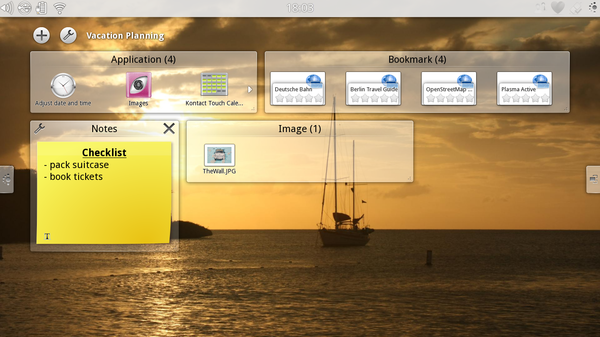KDE takes on Android, Apple's iOS on smartphones and tablets


So what is it? Plasma Active is not, like Android, iOS, or webOS, an operating system. It's a KDE 4.x style interface and application programming interface (API) designed for touch devices. The Plasma Active Team states that "Plasma Active is innovative technology for an intelligent user experience (UX). It is intended for all types of tablets, smartphones and touch computing devices such as set-top boxes, smart TVs, home automation, in-vehicle infotainment. The goals for this KDE open source project are:
- A fast embedded UX platform with minimal memory requirements
- Customizable and modular to support different form factors
- An interface that adapts as users change Activities.
In their GrandMaster Plan, the developers go into more detail about how they'll do this: "Plasma Active runs on the proven Linux desktop stack, including the Linux kernel, Qt and KDE's Plasma Framework. The user interface is designed using Plasma Quick, a declarative markup language allowing for organic user interface design based on Qt Quick. Plasma Active uses existing free desktop technology and brings it to a spectrum of devices through a device-specific user interface. Classical Plasma Widgets can be used on Plasma Active as well as newly created ones. The key driver for the development of Plasma Active is the user experience. Collaboration is made easy through high-level development tools and a well defined process. "
"The first release of Plasma Active fully focuses on tablet computers. Plasma Active Tablet's user experience is designed around the web, social networks and multimedia content." Today, Plasma Active runs on MeeGo and the openSUSE-based Balsam Professional (German language site). There are also OS images for Intel-based tablets, and package builds for ARM and x86 platforms. The group is working flashable images for ARM platforms. The interface will also run on Oracle's VirtualBox virtual machine. If you want to try it you can find downloads and instructions at the Plasma Active Installation page.
According to Sebastian Kügler, one of Plasma Active's leading developers Plasma Active is "certainly meant as a replacement for iOS and Android, a completely open, community-driven project with strong backing by a group of (SMB-sized) businesses. We hope this appeals to many hardware vendors, and have in fact already started talking with some. The feedback so far was very good, and the concepts seem to appeal with potential partners. There is definitely demand for an open system without lock-in in the market for devices."
Kügler also told me that they "have started investigating Tizen, [Intel and the Linux Foundations' proposed replacement for MeeGo] but at this point, there is too little information out, and too many unknowns. We do see Tizen as a potential and likely target platform, but before Intel and Samsung release an SDK, our hands are tied. It's not stopping us, since in the meantime, we can still run our stuff on MeeGo and Balsam, and we are investigating, together with the Mer team [Another mobile Linux operating system] how to get Plasma Active onto Mer.
That's all well and good but does KDE have any industry support for this? Kügler replied, "My employer, open-slx backs this project, and we are actively working towards creating a wider ecosystem of companies around Plasma Active, to make good commercial support available, next to the community resources. This includes OEMs, ODMs and companies that can deliver support around Plasma Active, for example integration with new hardware platforms, support for custom-build OS images, 3rd party software, end-user support, etc."
To that, I might add that unlike other such mobile projects, KDE starts with a large number of open-source applications that already run with it. That's an advantage that neither RIM nor HP had. Personally, it's hard for me to see a competitor to Android or iOS getting traction, but I've learned over the years not to bet against the KDE team.
Related Stories:
Is the PlayBook about to get killed? No way, says RIM
Intel, Linux Foundation drop MeeGo for Tizen
Gingerbread chasing Froyo; Ice Cream Sandwich unveiling delayed